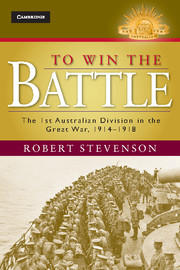Book contents
- Frontmatter
- Contents
- Photographs
- Maps
- Tables and figures
- Acknowledgements
- Abbreviations
- British military ranks
- Introduction
- Chapter 1 In the beginning
- Chapter 2 Organising for battle
- Chapter 3 Sinews of war
- Chapter 4 Already half a soldier
- Chapter 5 Into battle
- Chapter 6 Learning the hard way
- Chapter 7 Hitting the peak
- Chapter 8 The year of victory
- Conclusion
- Appendix 1 Divisional activities
- Appendix 2 Activity and location summaries
- Notes
- Bibliography
- Index
Introduction
Published online by Cambridge University Press: 05 February 2013
- Frontmatter
- Contents
- Photographs
- Maps
- Tables and figures
- Acknowledgements
- Abbreviations
- British military ranks
- Introduction
- Chapter 1 In the beginning
- Chapter 2 Organising for battle
- Chapter 3 Sinews of war
- Chapter 4 Already half a soldier
- Chapter 5 Into battle
- Chapter 6 Learning the hard way
- Chapter 7 Hitting the peak
- Chapter 8 The year of victory
- Conclusion
- Appendix 1 Divisional activities
- Appendix 2 Activity and location summaries
- Notes
- Bibliography
- Index
Summary
‘The past is a foreign country: they do things differently there,’ thus LP Hartley, as a traveller from a far-off shore, viewed his vanished world before 1914 and so eloquently described the relationship between those trying to understand people and events of the past. The Great War – or, as it came to be known, World War I – is indeed a foreign land to those living in the twenty-first century. On the one hand most would claim to know something of that cataclysmic event: the naïve enthusiasm for war, the unprecedented slaughter in the trenches, the unforgivable incompetence of the chateau generals and their callous staffs. At the same time nearly a century has passed since the assassination of Archduke Franz Ferdinand lit the fuse to war, all of the active participants are dead, and the reasons why millions of men and women willingly went to war (and, more importantly, stayed there) is quite incomprehensible to a present-day generation. It is not that war has not been experienced since; indeed the Great War set the tone for what followed, giving rise to so much that is truly modern, albeit in the process becoming a foreign land in spite of its familiar landscape.
The Great War continues to cast a long shadow over Australian culture. Despite, and in part because of, Charles Bean's monumental study of Australia's role in that conflict, myths and legends continue to prevail over reality. To many this war constitutes the epitome of war as horror, futility and stupidity. Paradoxically, alongside this revulsion lays a fascination with the achievements of the fledgling nation and the birth of the Anzac tradition, which has given rise to an industry of literature and cinema eulogising the common Australian soldier. Nearly 332 000 Australian Imperial Force (AIF) ‘diggers’ served overseas during the war, and they are one of the paramount Australian archetypes. To the average Australian these superb fighters were as remarkable as they are unique. This study explores the collective experience of some 80 000 diggers, although it does so by focusing less on them as individuals and more on the organisation in which they served.
- Type
- Chapter
- Information
- To Win the BattleThe 1st Australian Division in the Great War 1914–1918, pp. 1 - 11Publisher: Cambridge University PressPrint publication year: 2012



